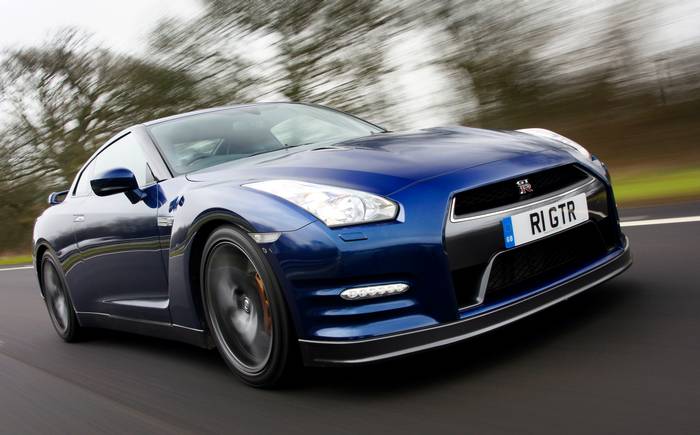The Clarkson review: Nissan GT-R (2011)

Are you a serious car enthusiast? I mean, really serious? Do you drive round every corner as fast as the laws of physics will allow? Do you open the taps whenever you can to revel in the intoxicating, mesmerising power of internal combustion? Does G-force tickle your G-spot? Do you talk about torque at parties? Are cars, for you, the light and the life and the meaning of everything? Right. Well why don’t you have a Nissan GT-R, then?
The GT-R is not designed to impress other people. There is no hand-stitched leather and no monogrammed luggage. It’s a Nissan, too — a Morphy Richards in a world where Dolce & Gabbana rules. Does it look good? No. Will it turn heads? No. But only because no one’s neck muscles can move that fast. The GT-R is designed to examine carefully the scientific laws that govern movement and then systematically to break them. It is designed to go faster than you ever thought possible, possess more grip than is physically allowed, change gear more quickly than you can blink and stop with such ferocity that you can actually feel your face coming off. No style. Just engineering.
Search for and buy a Nissan GT-R on driving.co.uk
It is made in a hermetically sealed factory, which is climatically controlled to ensure all the components are in the same state of thermal expansion when they go together. The tyres — this says a lot — are filled with nitrogen because the normal air used in humdrum cars such as Ferraris and Aston Martins is too unpredictable. It expands and contracts appreciably according to tyre temperature. Nitrogen does not. Then you have the wheels. They are knurled to stop the tyres coming adrift during cornering. Does a Ferrari have that? No. It’s not necessary.
The new 2011 GT-R is built along exactly the same lines but now there’s more power, more grip, more downforce and even more speed. It’s still not designed to impress your passengers. It’s designed to hurt them. Let’s begin with a standing-start full-bore acceleration run. You put the gearbox in race mode, and then you hold down the traction control button for a moment, put your left foot on the brake and mash your right foot into the carpet. When the revs have settled, and the 523-horsepower 3.8-litre twin-turbocharged engine is screaming its head off, you take your foot off the brake. What happens next is extraordinary. There is no wheelspin. The clutch does not slip. One second you are stationary, and the next you are doing 100mph. Imagine sitting in a deckchair in your garden on a summer’s day. It’s quiet and peaceful and you are enjoying the birdsong. Then you are hit from behind by a Boeing 747. That’s what the acceleration feels like in a GT-R. Absolutely unbefrigginglievable.
Of course, there are lightweight, low-riding trackday cars that, on paper, can get from 0 to 60 just as quickly. But they don’t get from 0 to 5 with anything like the savagery. And they run out of puff at 100. The GT-R does not. It just keeps on going, and when you get to the red line, you pull the paddle and instantly — not something that could be said of the previous model — the next gear is engaged. I have never experienced anything quite like it, if I’m honest. It’s wild. It’s relentless. It’s intoxicating. It’s amazing.
Certainly, you should never use the launch control in this car unless you are bracing your head against the headrest at the time. Because if you’re not, the whiplash could put you in hospital. It’s the same story in the corners, where the steering wheel becomes nothing more than a handle to hold on to so as to prevent yourself from being flung out of the seat. I should like very much to see an x-ray photograph of someone’s heart when they are cornering a GT-R, because one thing’s for sure. The G-force is so severe, there’s no way it would be heart-shaped.
I was desperate after just a couple of laps of the Top Gear test track to turn off the traction control. This would let the car slide, which would a) be more fun and b) reduce the pressure on my neck. But it’s not wise to turn off the safety features, because if you spin a GT-R, you will break many complicated components.
So, the GT-R is very good. But I know what you’re thinking. You’re thinking that you’d still much prefer a Ferrari 599 or Aston Martin DBS. If that’s the case, I’m obviously not getting the message across. The Nissan will eat cars like this. Chew them up; spit them out. Bring whatever you like to the party. The GT-R will blitz it. It blitzes everything. It recently blitzed the Nürburgring in 7 minutes and 24 seconds. Do you know anything else with numberplates that could get round as fast? Because I don’t.
Of course, a Ferrari is a much nicer thing to own and to behold and to touch, but when it comes to the business of driving, or going from point A to point B as fast as possible, no Ferrari would see which way the GT-R went. Ferrari is Manchester United. The GT-R is Barcelona. There are, however, some problems. First of all, it is extremely ugly. It tries to be unshowy in the same way as a bouncer tries to be unshowy when he slips into a dinner jacket. You can always see the tattoos and the neck like a birthday cake, so you know.
You know with the GT-R, too, because of the scoops and the exhaust tailpipes, which are even fatter than before. Inside, it’s worse. I can see what Nissan has tried to do. Keep it simple. But the slab of carbon fibre on the centre console is embarrassing, and the central command unit, which shows you the state of all the components and how many g you generated in the last bend? No. It’s all a bit too fast and furious for my taste. A bit too Jason Statham.
I wish Nissan had had the guts to truly hide its light under a bushel. As it did with the old Skyline. Not to pretend. But, that said, the GT-R is a proper four-seater and it has a boot into which you could fit many things. It is also surprisingly quiet and remarkably comfortable even on a traditional potholed British road. Of course, there’s a harshness to the feel, a sound that hints at the racetrack, but there’s no volume. And I like that. I also like the price. Yes, it’s rocketed up by about £10,000 to £69,950, and that’s a lot for a Nissan.
But it’s much less than half what you’d have to pay for a slower, less electrifying Ferrari 458. And it’s not as though the salesman can mug you with a list of options, because I’ve been on the online configurator and there aren’t any.
The new GT-R is demonstrably better than the old one. It’s faster, and the gearbox is a significant improvement. This means it’s demonstrably better than what was a benchmark. Yes, it’s an ugly son of a bitch, and there are some stupid gimmicks, but this car is a genuine phenomenon. You’re interested in cars. You love driving. You like engineering. You have to have a GT-R. It’s that simple.
Search for and buy a Nissan GT-R on driving.co.uk





